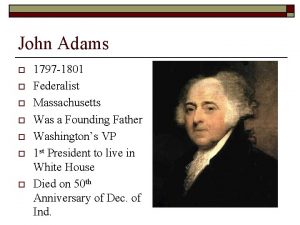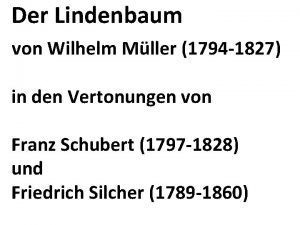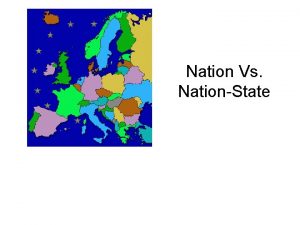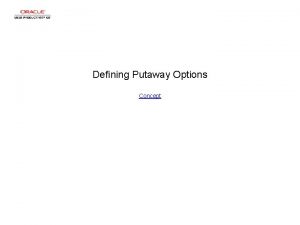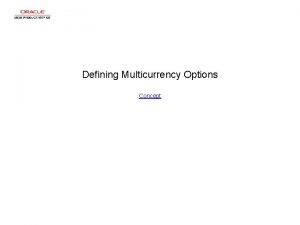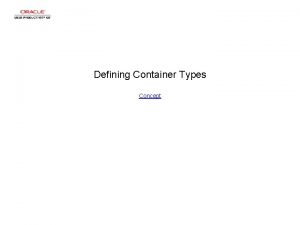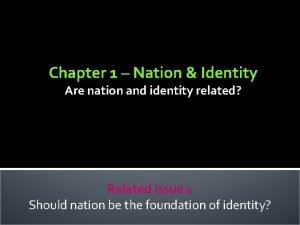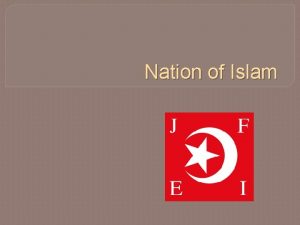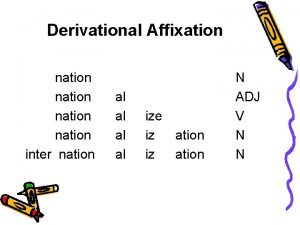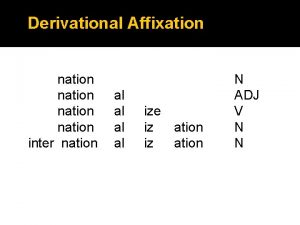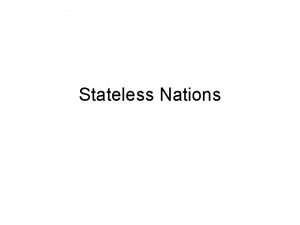Ch 8 Defining the Nation 1801 1823 I








































- Slides: 40

Ch. 8: Defining the Nation, 1801– 1823

I. Political Visions Separation of Church and State § Jefferson seek separation of church and state, “wall of separation” Religious Revivals § Religious revivalists/egalitarians praise this § Federalists disparage excesses of democracy

I. Political Visions (cont’d. ) The Partisan Press § Use marches, petitions, symbolism § E. g. , mammoth cheese § Newspapers = key forum for political conversation and almost all quite partisan § Each party have an official newspaper

I. Political Visions (cont’d. ) Limited Government §Extend “Democratic”-Republican control over executive branch via appointments §Repeal internal taxes, cut military budgets, and reduce national debt §because Jefferson’s vision including individual liberty, §Let Alien and Sedition Acts expire

p 212

I. Political Visions (cont’d. ) Judicial Politics § § Last Federalist stronghold Esp. appointment of Marshall by Adams Jeffersonians see judiciary as undemocratic Congress impeach some Federalist judges

I. Political Visions (cont’d. ) The Marshall Court § Stress Federalist vision: § supremacy of US government § protect commerce/ capital § Marbury v. Madison (1803) = astute decision that avoid conflict with president Judicial Review § Assert power of judicial review

I. Political Visions (cont’d. ) Election of 1804 § § § Jefferson easily defeat Federalist Pinckney Both had North-South balance on ticket Violent (Hamilton-Burr Duel, 1804) Burr tried for treason (secession scheme) Flee to Europe after acquittal

II. Continental Expansion and Indian Resistance § Many move to Ohio and Mississippi valleys § Cotton gin (1793) key § Boom to cotton/slave economy in South

p 215

II. Continental Expansion and Indian Resistance (cont’d. ) New Orleans §Spain cede LA to France (1800– 01) §Threaten vital US trade on MS River §Jefferson able to buy territory §Double size of USA Louisiana Purchase §Federalists oppose §Bring in number of diverse peoples, esp. LA

Map 8 -1 p 216

II. Continental Expansion and Indian Resistance (cont’d. ) Lewis and Clark Expedition § § Corps of Discovery journey to Pacific Reports encourage nationalism Sacagawea and York: neither pay nor freedom Whites continually shrink Indian lands

p 217

III. The Nation in the Orbit of Europe Threats to American Sovereignty § USA also angered by § British impressment § Chesapeake affair (1807) The Embargo of 1807 § § US not prepared for war Avoid war by embargo on all US exports Hurt US trade more than belligerents Boost domestic manufacturing

III. The Nation in the Orbit of Europe (cont’d. ) The Embargo of 1807 § § US not prepared for war Avoid war by embargo on all US exports Hurt US trade more than belligerents Boost domestic manufacturing

p 222

III. The Nation in the Orbit of Europe (cont’d. ) Early Abolitionism and Colonization § Pre-1830 s, few whites support abolition § American Colonization Society (1816): § gradual, voluntary abolition § deportation to Africa (Liberia, 1824)

p 223

III. The Nation in the Orbit of Europe (cont’d. ) Election of 1808 § Democratic-Republicans win with Madison § Federalists gain in Congress by opposing embargo Failed Politics § Embargo collapse because of opposition § Non-Intercourse Act (1809) § Reopen US trade except with belligerents

III. The Nation in the Orbit of Europe (cont’d. ) Mr. Madison’s War §Democratic-Republicans demand war §“War-Hawks” also want expansion west and maybe north (Canada) §War-Hawks strong in South and West §Coastal areas and Federalists oppose war §Madison reelected in 1812

Map 8 -2 p 226

IV. War of 1812 § § Series of scuffles and skirmishes, Neither Army nor Navy prepared for war Lack equipment, officers, and enlistees Lack of state support (New England, NY) hamper land operations Invasion of Canada § Invasion of Canada (1812– 13) = disaster § By 1814, England blockade coast

IV. War of 1812 (cont’d. ) Naval Battles § USA score win in Great Lakes (1813) Burning Capitals § Harrison secures Old Northwest § Tecumseh ally with England § British burn US capital (1814) in retaliation for destruction of York (1813)

IV. War of 1812 (cont’d. ) War in the South §Jackson: § defeat Creeks at Horseshoe Bend (1814) § get ½ of Creek land in Treaty of Fort Jackson § defeat English at New Orleans (1815) §New Orleans make Jackson national hero even though peace treaty already signed

IV. War of 1812 (cont’d. ) Treaty of Ghent § Ignore neutral rights, but with European war over, no more actions against US trade American Sovereignty Reasserted § Victory strengthen § US independence § desire to avoid European politics

IV. War of 1812 (cont’d. ) Domestic Consequences §Destroy Federalists; they opposed war §Hartford Convention (1814– 15) §Talk of secession and government change §Rising nationalism (New Orleans win) paint Federalists as traitors §US victory = disaster for Indians §Lose: § potential ally (British) § effective leader (Tecumseh) § much land

IV. War of 1812 (cont’d. ) Domestic Consequences (cont’d. ) §War accelerate key trends: § (1) westward expansion § (2) industrial takeoff § (3) entrenchment of slavery §“American System” = promote economic growth to unify nation via trade/ commerce

V. Early Industrialization Putting-Out and Early Factories §Pre-1812, “putting-out” system starts §Merchants pay farm women/kids piece-work wage to make goods for sale §Link with first factories §First spinning mill (RI, 1790) use system to convert thread into cloth §Ties farm women/kids to wages and markets

V. Early Industrialization (cont’d. ) Putting-Out and Early Factories §War of 1812 increases US investment in factories to replace European goods §Northern industrialization tied to Southern slavery in cotton production §Early northern industry linked to slavery: § use South’s cotton § early capital from slave trade § South = market (e. g. , shoes)

p 229

p 231

p 232

VI. Sectionalism and Nationalism American System § re-charter US Bank § pass protective tariff § fund roads/canals, but Madison veto (1817) Early Internal Improvements §Congress later extend National Road §Most roads/canals funded by states/private § 1816 Monroe (last founder as president) win ushers in the “Era of Good Feelings”

VI. Sectionalism and Nationalism (cont’d. ) Panic of 1819 §Easy credit = base for economic boom §Financial panic/downturn (1819– 23) devastate many Missouri Compromise §Missouri try to enter as slave state (1819) §Tip Senate balance & northern reach of slavery §Clay craft compromise (1820): balance of MO with ME and ban slavery in LA Territory north of MO’s southern boundary §Compromise = temporary fix to contentious issue of slavery’s westward expansion

Map 8 -3 p 236

VI. Sectionalism and Nationalism (cont’d. ) The Era of Good Feelings § Supreme Court spur economic growth and nationalism in Mc. Culloch v. Maryland (1819) § Void state tax on US Bank § Assert supremacy of US government over states; doctrine of implied powers (Hamilton) § Gibbons vs. Ogden (1824) void state monopoly on steamboat trade

VI. Sectionalism and Nationalism (cont’d. ) Boundary Settlements § 1817 Rush-Bagot Treaty disarm Great Lakes §Convention (1818) settle border with Canada §Adams-Onis Treaty (1819): § US get Florida § recognize Mexico’s claim to Texas § set other US-Spanish borders §USA already occupy FL with first Seminole War (1817 -18) under Jackson

VI. Sectionalism and Nationalism Monroe Doctrine §Much of Spanish empire declare independence (1808– 1822) §US and England fear French intervention §An independent statement by USA (1823) §No European colonization or intervention in West Hemisphere

Map 8 -4 p 238
 Non defining relative clause examples
Non defining relative clause examples Relative clauses cümleden atılması
Relative clauses cümleden atılması Relative clauses defining and non defining
Relative clauses defining and non defining Define and non defining relative clauses
Define and non defining relative clauses Defining and non-defining
Defining and non-defining Defining and non defining relative clauses in telugu
Defining and non defining relative clauses in telugu Envidata 1801
Envidata 1801 Poeet 1801-1822
Poeet 1801-1822 John adams 1797-1801
John adams 1797-1801 Der lindenbaum text
Der lindenbaum text 1823-1749
1823-1749 Ensayos constitucionales de chile entre 1823 y 1830
Ensayos constitucionales de chile entre 1823 y 1830 Patria nueva 1817 a 1823
Patria nueva 1817 a 1823 Nation vs state
Nation vs state Theories of origin of state
Theories of origin of state Example of nation
Example of nation Frameset trong html5
Frameset trong html5 Hệ hô hấp
Hệ hô hấp Các số nguyên tố là gì
Các số nguyên tố là gì đặc điểm cơ thể của người tối cổ
đặc điểm cơ thể của người tối cổ Mật thư anh em như thể tay chân
Mật thư anh em như thể tay chân Các châu lục và đại dương trên thế giới
Các châu lục và đại dương trên thế giới Chụp tư thế worms-breton
Chụp tư thế worms-breton ưu thế lai là gì
ưu thế lai là gì Thẻ vin
Thẻ vin Tư thế ngồi viết
Tư thế ngồi viết Bàn tay mà dây bẩn
Bàn tay mà dây bẩn Các châu lục và đại dương trên thế giới
Các châu lục và đại dương trên thế giới Từ ngữ thể hiện lòng nhân hậu
Từ ngữ thể hiện lòng nhân hậu Bổ thể
Bổ thể Tư thế ngồi viết
Tư thế ngồi viết Thế nào là giọng cùng tên?
Thế nào là giọng cùng tên? Làm thế nào để 102-1=99
Làm thế nào để 102-1=99 Thơ thất ngôn tứ tuyệt đường luật
Thơ thất ngôn tứ tuyệt đường luật Alleluia hat len nguoi oi
Alleluia hat len nguoi oi Sự nuôi và dạy con của hươu
Sự nuôi và dạy con của hươu đại từ thay thế
đại từ thay thế Diễn thế sinh thái là
Diễn thế sinh thái là Vẽ hình chiếu vuông góc của vật thể sau
Vẽ hình chiếu vuông góc của vật thể sau Công thức tiính động năng
Công thức tiính động năng Thế nào là mạng điện lắp đặt kiểu nổi
Thế nào là mạng điện lắp đặt kiểu nổi








